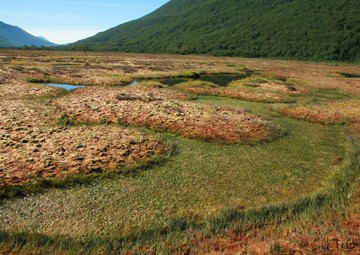CandyBog
Carbon, water and nutrient dynamics in vascular plant- vs. Sphagnum-dominated bog ecosystems in southern Patagonia

The project CANDYbog deals with temporal and spatial patterns as well as processes controlling matter fluxes in South Patagonian peatlands. In contrast to their northern counterparts that are often heavily anthropogenically influenced and well-investigated, these pristine southern peatlands are only poorly studied. Therefore, South Patagonian peatlands allow for the investigation of matter fluxes under nearly undisturbed conditions which is almost impossible in the northern hemisphere. Beside bogs dominated by peat-forming Sphagnum mosses that are also typical for the northern hemisphere, also bogs that are dominated by cushion-building vascular plants can be found in South Patagonia. So far, it is almost unknown which conditions lead to either the development of cushion bogs or Sphagnum bogs. Undisturbed bogs have an important carbon storage function in the global carbon cycle. However, the carbon source and sink dynamics of South Patagonian bogs have not been investigated so far and thus it is unclear, how much carbon is stored or released, particularly by cushion bogs. The aim of the CANDYbog project is therefore to quantify the carbon, nutrient and water balance of South Patagonian peatlands as well as to identify and better understand the key processes controlling nutrient and carbon dynamics in these peatlands.
Beside the relevance for the global carbon cycle, a better functional understanding of South Patagonian peatlands is particularly promising because they can be considered as model systems for undisturbed peatlands in the northern hemisphere. Therefore, South Patagonian peatlands can be particularly suitable to investigate the response of peatlands to changing environmental conditions, for example caused by global change including climatic changes or elevated atmospheric nitrogen inputs. It is expected that these changes in environmental conditions affect the vegetation composition and carbon storage function of peatlands. In this context, the cushion bogs may be an example of the expected changes in the vegetation composition of the northern hemispherical bogs towards a greater dominance of vascular plants. Thus, the results might give valuable insights for the conservation and restoration of bogs in the northern hemisphere.
Among others, the research questions deal with
- the differences in carbon and water balances between vascular plants and Sphagnum-dominated peatlands, especially in response to different environmental conditions
- the effects of experimental shading and fertilization on Sphagnum mosses and cushion-forming vascular plants, on peat decomposition rates as well as nitrogen dynamics
- the long-term carbon sequestration rate of South Patagonian bogs

PIs: Prof. Dr. Kleinebecker, Prof. Dr. Klaus-Holger Knorr (WWU Münster), Prof. Dr. Lars Kutzbach (University of Hamburg)
Argentinean partner: Dr. Veronica Pancotto (Centro Austral de Investigaciones Científicas (CADIC), Ushuaia)
Duration: 2013-2018
Funding: DFG
Publications:
- Münchberger W, Knorr KH, Blodau C, Pancotto VA, Kleinebecker T (2019) Zero to moderate methane emissions in a densely rooted, pristine Patagonian bog – biogeochemical controls as revealed from isotopic evidence. Biogeosciences 16: 541-559
- Münchberger W, Reimann N, Knorr KH, Gałka M, Borken W, Blodau C, Pancotto VA, Kleinebecker T (2018) Carbon cycling in contrasting pristine bogs in southern Patagonia (Tierra del Fuego, Argentina). Poster, European Geosciences Union, General Assembly 2018. Wien, 7-12/04/2018
- Lehmann JRK*, Münchberger W*, Blodau C, Nieberding F, Knoth C, Prinz T, Pancotto VA, Kleinebecker T (2016) High-resolution classification of South Patagonian peat bog microforms reveals potential gaps in up-scaled CH4 fluxes by use of Unmanned Aerial Systems (UAS) and CIR image classification. Remote Sensing 8(3): 173 [doi:10.3390/rs8030173] (* equal authorship)
- Münchberger W, Blodau C, Kleinebecker T, Pancotto VA (2015) CO2 and CH4 fluxes of contrasting pristine bogs in southern Patagonia (Tierra del Fuego, Argentina). Poster, European Geosciences Union, General Assembly 2015. Wien, 12-17/04/2015
